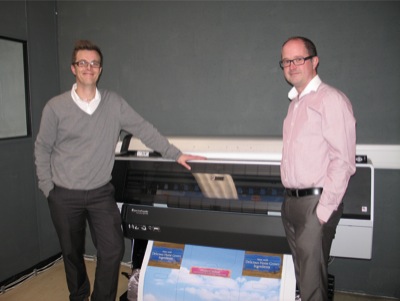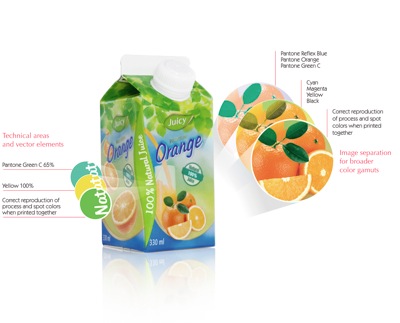Multicolour printing for packaging presents many challenges when it comes to producing accurate proofs. Managing director of GMG UK, Toby Burnett, discusses some of the issues, particularly how to predict overprint behaviour of spot colours.
A continuing trend in package printing is the increasing complexity of jobs and the use of multicolour printing, while meeting brand owner demands to reduce time to market at the same time. Many packaging jobs require different combinations of inks, substrates, screening and other variables. A chocolate wrapper might have two browns, fruit juice cartons may have oranges, greens and reds.
The inability to accurately proof ‘spot colour overprint’ or ‘multi channel profiling’ or ‘extended gamut printing’ poses one of the biggest challenges – along with reliably communicating this colour between all parties of the supply chain, from the brand manager to the printer.
There has not been an effective and accurate way to predict the behaviour of spot colours that print on top of each other. For example, if a 40% spot colour green is overprinted by an 80% spot colour ‘red’ (green on top of red), what is the resulting colour on a flexo press? Until now, we didn’t know. The underlying science to predict this behaviour had been missing.
To make it even more complex, each printing process overprints differently. Flexo does not overprint like gravure – the ink film thickness and trapping properties are very different. Then, consider the unique information needed to accurately predict the overprint behaviour of two custom spot colours: on a given flexo press, with a given anilox, at a given line screen, with food grade inks. Using typical L*A*B* based measurements, the industry has become adept at making solid colours appear similar across different printing processes, but that is about it.
New methodology
For a combination of four inks you needed a CMYK IT8.7/4 test chart that actually printed 1617 patches, a costly and time-consuming process. The number of patches required to print grew exponentially with each additional ink.
A new methodology has been introduced that predicts actual ink behaviour, on a specific substrate for each press set-up – without the rigours of ‘proprietary chart based’ press fingerprinting. It resolves this complex packaging problem and provides better results, with less information.
How is this done? New spectral modelling algorithms are coupled with spectral ink measurements that analyse the properties of each ink colour, as well as the substrate’s colourimetric properties. This information is applied to a specific printing process (flexo, offset, gravure).
A profile could be created with just the solid patches of the spot colours on the substrate, although better results would be achieved if multiple steps (50%, 30%, 10%, etc) of the spot were measured, improving the end result. Traditional press fingerprinting charts are supported, and the new technology can use existing press characterisations to refine accuracy.
The technology also allows the substitution of the substrate within the profile (when ink behaviour conditions are similar). In this case, the colour values of one substrate can be replaced by the values of another substrate.
This avoids the time consuming and costly process of collecting redundant data because of a small change to the job parameters. The system also allows for print sequence changes, ink substitution and dynamic profile re-calculation on the fly. In many cases, the relevant measurement data can be gathered from control patches included in actual production runs.
Measurements are centrally saved and categorised according to print variables. This lets operators build an archive of measurements and to combine existing measurements to new profiles, whenever a new combination of inks must be profiled. Accuracy is increased by adding more overprint readings.
Then process specific information is added (ink rotation, trapping, etc), and the final press condition is simulated on a proof. For a printer, this has a profound effect on performance. It allows for more packaging standardisation and shorter production cycles. Special products made for a limited time (for example, Valentine or Christmas treats) could be more economical, because colour testing would be easier. Colour and ink combinations that are affected by food safety can be tested much more quickly. And, with less time spent on makereadies and materials, the carbon footprint is reduced.
 Gareth Heward, graphics and production director (right) and Shaun Mettam, studio manager, V&W Graphics
Gareth Heward, graphics and production director (right) and Shaun Mettam, studio manager, V&W Graphics
Mastering multicolour
Flexographic platemaker V&W Graphics, based in Alford, Lincolnshire, has recently invested in GMG OpenColor proofing software to increase proofing accuracy for its corrugated, pre-print and flexible packaging work. The company works with printers around the country who produce packaging for various blue-chip brands and retailers.
‘Over recent years increasing job complexity and a greater use of spot colour inks has placed increased importance on the production of accurate and consistent proofs,’ said Gareth Heward, graphics and production director.
‘The issue that we found with most proofing software was that they were based on a CMYK proofing model. Since more and more of our packaging work falls outside of a four colour process gamut, we needed a solution that could both calibrate and reproduce the increasingly diverse range of work that our customers produce.
‘Spot colours have very different colour characteristics to process inks, and the result can be affected by the sequence that the inks are laid down when printed,’ continued Mr Heward.’Being able to profile more than process colours was becoming more and more of a requirement.
‘One particular job highlighted our problem: a panel of a packaging job that proofed out as a bright orange but printed more of a muted yellow. We showed the job to GMG which ran it through OpenColor and shipped the proof back to us the next day. Considering the time that we normally take on profiling and calibration, the fact that it could turn around a proof so quickly, that was so close to the final result was astounding.’
OpenColor is the industry’s first application to offer precise and predictable spot colour simulation by analysing ink behaviour in relation to the substrate’s colorimetric properties.
The result is a profiling and calibration application that delivers accurate spot colour overprint simulation as well as the interplay between spot colours and process inks. V&W’s used the solution driving a 44 inch Epson Stylus Pro 9900 complete with inline spectrophotometer for automated colour measurement and calibration.
‘Previously we could be spending quite a lot of time with creating a number of iterations of the proof, tweaking it manually to give the best result possible for our customers. Today, the process is a lot simpler and the resulting proof is more accurate to boot.’
Mr Burnett commented, ‘With OpenColor we have developed specific spectral modelling algorithms for flexo, gravure and offset printing as opposed to a ‘one size fits all’ approach. This enables us to deliver more precise and consistent spot colour simulations for a wide range of print technologies and media substrates. As the packaging market continues to evolve and client expectations increase regardless of the underlying print process, GMG OpenColor allows service providers to deliver faster, more accurate proofing results time after time.’
Savings
Globally, current press fingerprinting within offset, flexo and gravure packaging printing incurs millions of pounds of expenses every year. This high cost often yields poor results, thus raising costs even further. If the cost of customer satisfaction, erosion and re-work is factored in, the actual cost is even higher. The new technology improves the quality of the final result (customer satisfaction) while greatly reducing fingerprinting costs.
Once the ability to predict overprint behaviour is available, the next step will be for producers of packaging to eliminate inks not needed (usually C, M, Y or K), achieving acceptable gamut through the use of mostly line colours on press. This will let pre-press companies and converters eliminate colours within a job (without changing its appearance), reducing the press stations needed while not compromising the line colours required. The creation of this type of artwork is very expensive and is often created with trial and error methods. As better ways of producing these separations evolve, the overall reduction of inks on press will further reduce costs across the entire supply chain.






